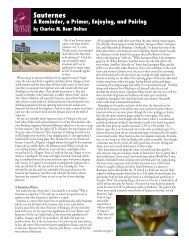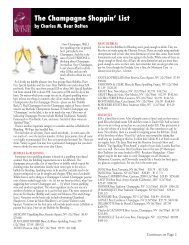What I Tasted on My Spring Break - SPEC's Liquors
What I Tasted on My Spring Break - SPEC's Liquors
What I Tasted on My Spring Break - SPEC's Liquors
You also want an ePaper? Increase the reach of your titles
YUMPU automatically turns print PDFs into web optimized ePapers that Google loves.
713-526-8787<br />
By Charles M. Bear Dalt<strong>on</strong><br />
Do your reds have a fever Do your whites have the<br />
chills I've said it before and I'll say it again: wine tastes<br />
better when it is served at the right temperature. So<br />
what's the right temperature It is NOT room<br />
temperature for reds and refrigerator temperature for<br />
whites. At typical Houst<strong>on</strong> summer room temperatures<br />
(75-78°), red wines feel warm and the alcohol dominates<br />
the aromatics. At typical refrigerator temperature (34-<br />
38°), white wines (and rose and Champagne) are too<br />
cold to release much in the way of aroma and flavor.<br />
Red wines should always be served at cellar temperature<br />
(55-60°). At 60°, the fruit aromas are able to show their<br />
best and the alcohol is muted. The wines both taste<br />
better and feel better in the mouth. This is particularly<br />
important with today's higher alcohol, riper-style red<br />
wines. It is much better to serve reds a little bit too cool<br />
rather than any bit too warm. They will gradually (or in<br />
Houst<strong>on</strong> in the summer maybe not so gradually) warm<br />
up in "room temperature" surroundings.<br />
By the same token, white wines should be removed from<br />
the refrigerator and allowed to warm up a bit so that they<br />
are in the 45-48° range when they are served. That ten<br />
degrees makes all the difference in the world as to the<br />
flavors and aromatics of a white wine and how the wine<br />
feels in the mouth. I can think of no wine I'd ever<br />
intenti<strong>on</strong>ally serve colder than 45°. A rich, full-bodied<br />
Chard<strong>on</strong>nay from California or Burgundy might even be<br />
better served as warm as 55° (the minimum temperature<br />
for serving red wines).<br />
Knowing the right temperature and serving the wines at<br />
the right temperature are two different things. So how do<br />
you get the wines to the right temperature The best way<br />
is to have temperature c<strong>on</strong>trolled wine storage. It doesn't<br />
have to be a wine room or closet or even an armoir-sized<br />
unit. There are 24 and 30 bottle units available that are<br />
smaller than a dishwasher. Once you get used to having<br />
<strong>on</strong>e of these and serving your wines at the right<br />
temperature, you'll w<strong>on</strong>der how you ever made it<br />
without <strong>on</strong>e.<br />
If temperature c<strong>on</strong>trolled storage is not practical for you,<br />
there are other ways. Cool reds off quickly by decanting<br />
them into a glass carafe you keep in the freezer. The<br />
frozen carafe will quickly cool the wine which can then<br />
be poured from the carafe into glasses. It is a good idea to<br />
keep a plastic bag over the open end of the carafe with a<br />
rubber band to keep it sealed to keep any "off" aromas<br />
from accumulating in the carafe. Also, plastic ice cubes<br />
added to a glass of already poured too-warm red will get<br />
things back in order without diluting the wine.<br />
Unfortunately, refrigerator temperature whites just take a<br />
while to warm up. One piece of good news is that they<br />
do warm up faster in the glass than they do in the bottle.<br />
If they get too warm too so<strong>on</strong>, just add a couple of the<br />
aforementi<strong>on</strong>ed plastic ice cubes and you are set.<br />
If you follow this advice, your wines will taste better<br />
and be more refreshing. You'll be drinking better and<br />
enjoying your wine more without spending any more<br />
m<strong>on</strong>ey.<br />
BECKMEN<br />
Cuvee Le Bec,<br />
Santa Ynez<br />
2002<br />
$12.92 bottle $143.91 case<br />
12x750ml<br />
A very Chateauneuf-like blend of 46%<br />
Grenache. 23% Mourvedre, 22% Syrah,<br />
and 9% Counoise, this is a lovely,<br />
succulent red that splits the difference<br />
between the southern Rh<strong>on</strong>e and<br />
Aussie GSM wines. It offers fine grapey<br />
mixed berry fruit accented with mixed<br />
black and white pepper, spice, and a bit<br />
of earthy terroir charater. It is wellintegrated<br />
enough to be hard to<br />
describe but it is very easy to drink.<br />
Lovely wine. Excellent.<br />
Bear's Score: 92 points.<br />
IRONSTONE<br />
Xpressi<strong>on</strong>,<br />
California<br />
2003<br />
$5.77 bottle $64.25 case 12x750ml<br />
It doesn't matter whether you treat this<br />
as a dark, rich rose or a light-weight<br />
chillable red. <str<strong>on</strong>g>What</str<strong>on</strong>g> you get is a fresh,<br />
refreshing light-weight, semi-dry wine<br />
offering good cherry, cranberry, and<br />
strawberry fruit with notes of earth<br />
and black pepper and just enough<br />
residual sugar to make it very<br />
refreshing and allow it to accompany<br />
spicy foods. I think of it as a fairly<br />
serious semi-dry rose. Keep an open<br />
mind and serve it with spicy gumbo or<br />
jambalaya, spicy fried chicken, or<br />
outdoor dining that requires a cool or<br />
even cold "red" wine. Surprisingly<br />
delicious. Very Good. Bear's Score:<br />
86+ points.





